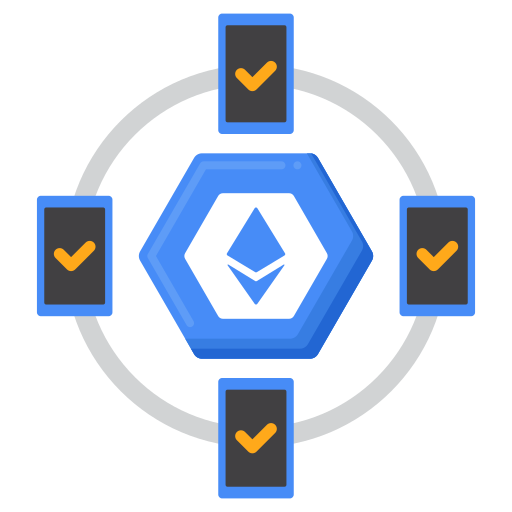Development of a Dapp



Author: Gerard Castell Ferreres
Advisor: Jose Luis Muñoz Tapia Barcelona
Barcelona, October 26, 2023
- Introduction
- State of the art
- Blockchain
- Ethereum
- Project development
- Results
- Conclusions
Outline
Introduction
1
In today's digitalized world everyone and everything is connected through the Internet

- Be complex
- Have a lack of transparency
- Involve intermediaries
Their processes use to:
Introduction
1
Information governance problem
Generates a huge amount
of data
Companies govern the information management


Web 2.0
Web 3.0
The Internet and web applications play a main role in this interconnectivity between people and companies
Centralization

Companies have monopolized:
- User data
- Platform access
- Content distribution
Decentralization
Dapps offer a digital experience:
- Public
- Transparent
- User-centric




Introduction
1
Web evolution

Dapps
Technological innovation
Growing desire of transparency and user control
Rethinking of traditional web limitations
Introduction
1
Emergence of dapps
Decentralized applications are applications built on a decentralized network that run software programs and are accessed through a frontend user interface.
Blockchain

Smart contracts


Web application

Introduction
1
Definition

Introduction
1
Benefits of building dapps with blockchain smart contracts
Control Decentralization. No single authority controls the data.
Trustless Environment. Trust is distributed across the network rather than being concentrated in a single entity.
Censorship Resistance. Access to smart contracts is open and any single entity can censure their access.
Transparency. The transparent nature of blockchain allows the users to verify our data.
Data Integrity. Data stored is cryptographically secured, making it really challenging for anyone to corrupt.

Traditional and centralized digital product


Introduction
1
Statement of purpose
Objective: Develop a dapp solution for replacing a centralized business case in order to harness the capabilities provided by blockchain and smart contracts.
Decentralized Application

Decentralized Application
Traditional and centralized digital product


Introduction
1
Statement of purpose
convert to
Objective: Develop a dapp solution for replacing a centralized business case in order to harness the capabilities provided by blockchain and smart contracts.
Introduction
1
Business case
- No partial refund when canceling a policy
- Delay in receiving an insurance claim
- Slow and opaque third-party communication


Car insurance
Centralized server
Centralized model of car insurance
Drawbacks
Introduction
1
Business case


Centralized model of car insurance
Introduction
1
Business case
convert to

Centralized model of car insurance


Decentralized model
of car insurance
Introduction
1
Business case


Decentralized model
of car insurance
-
Efficiency: Smart contracts automate claims payouts, reducing paperwork and administrative overhead.
-
Ownership: Control gets distributed through the network so no single entity controls the data.
-
Transparency: The blockchain participants can access the network whenever. Policyholders and insurers can track the status of claims and policies.
-
Integrity: Users trust in the integrity of the policy data thanks to the blockchain nature.
- More advantages...
Advantages


What do we need to know
to build the dapp?


Decentralized model
of car insurance
Introduction
1
What do we need to know to build the dapp?
State of the art
2
Blockchain
2.1
A blockchain is a way of building a distributed ledger where the transactions that modify the ledger’s state are sequentially and immutably ordered by consensus.
Blockchain
Definition
2.1
Block

State t

Chain

Node

Blockchain
Anatomy
2.1
A blockchain is a way of building a distributed ledger where the transactions that modify the ledger’s state are sequentially and immutably ordered by consensus.
refers to data that conforms the state
refers to each block referencing its parent
refer to the computers which shape the network
Nodes
Block
Chain


State t


Blockchain
Anatomy
2.1
Block: refers to data that conforms the state
Chain: refers to each block referencing its parent
Nodes: refer to the computers which shape the network
Nodes
Block
Chain


State t







State t'


State t''



Blockchain
Anatomy
2.1


State t







State t'


State t''



Permissionless
Permissioned
Hybrid
Consortium
Depending on who can participate in the blockchain we may classify them in four types:
Blockchain
Classification
2.1


State t







State t'


State t''



Permissionless

Ethereum

Bitcoin
Blockchain
Permissionless blockchains
2.1


State t







State t'


State t''



Permissionless

Alice

Bob
Transactions
Transactions

Ethereum
Blockchain
Permissionless blockchains
2.1


State t







State t'


State t''



Distributed Ledger
How do we identify senders in the ledger?

Alice

Bob
Blockchain
Authentication
2.1
Blockchain
Public Key Cryptography (PCK)

Alice

Bob








Each one of them has a key pair:
- The public key (pk) which everybody knows it belong to the user.
- The private key (sk) which the user keeps secret.
2.1
Blockchain
Digital Signature Authentication
Authentication is the act of proving an assertion, in this case, the identity of the sender which is represented by a public key.

Bob

Alice

Cypher
Digital Signature
Message
Signature
Message
Message

Decypher
2.1
Blockchain
Transactions


State t




State t'


State t''




Alice
All transactions are authenticated through digital signature, which means they can only be generated by the corresponding owners.

Ethereum
Transaction 1

Bob
Signature
Message
Signature
Message
Transaction 2
2.1
Blockchain
Consensus


State t




State t'


State t''




Ethereum
Transaction 2
Signature
Message
Transaction 1
Signature
Message


2.1
Do we need to order transactions in the ledger if they are authenticated?
Tx 2
Tx 1
Node B
State t

State t'

State t'

State t

Tx 2
Tx 1
Node A
Tx1: Alice sends to Bob 1 unit
Tx2: Bob sends to Charlie 2 units
Distributed ledger at State t

| Address | Balance |
|---|---|
| a11... (Alice) | 3 units |
| b9b (Bob) | 1 units |
| ca7... (Charlie) | 1units |
Distributed ledger at State t
State t' in option A is different from option B!!
If we focus on option B, by selecting Tx2 before Tx1, Tx2 is invalid because Bob does not have 2 units to send.
However, sending Tx2 after Tx1
makes both transactions valid, so the order is very relevant.
We need consensus to select an order in the distributed ledger
Blockchain
Consensus
2.1
Consensus mechanism must satisfy some requirements
Agreement
Two correct replicas (processes) cannot decide different values.
Validity
The decided value is a value proposed by some replica.
Termination
All correct replicas eventually decide some value.
Blockchain
Consensus mechanisms
2.1
Consensus mechanism must satisfy some requirements
Agreement
Validity
Termination
Consensus mechanisms
Proof of Work
Proof of Stake
Proof of Authority

Ethereum

Bitcoin
Blockchain
Consensus mechanisms
2.1
Blockchains use consensus mechanisms referring to the stack of protocols, incentives and ideas that allow a network of nodes to agree on the state of the blockchain
Consensus mechanisms
Proof of Work
Proof of Stake
Proof of Authority

Ethereum

Bitcoin
Blockchain
Consensus mechanisms
2.1
A cryptocurrency is a digital asset to exchange secured and trusted by a blockchain ledger.
Each blockchain implements different cryptocurrencyies.
The ledger reflects the amount of a cryptocurrency that each address own.
Ether (ETH)

Bitcoin (BTC)

Blockchain
Cryptocurrencies
2.1
Ether (ETH)

The Ethereum ledger reflects the amount of Ethers that each address own.

| Address | Balance |
|---|---|
| a11... (Alice) | 3 ETH |
| b9b (Bob) | 1 ETH |
| ca7... (Charlie) | 1 ETH |
Ethereum ledger at State t

Blockchain
Ethers
2.1


State t




State t'


State t''




Alice

Ethereum
Transaction 1

Bob
Signature
Message
Signature
Message
Transaction 2
Wallets appeared in order to ease communication with the blockchain networks and manage all cryptographic items from a user point of view.


Usability
Blockchain
Wallets
2.1


State t


Balance



State t'


State t''




Alice

Ethereum
Tx 1 signed

Bob
Tx 2 signed



Balance
Usability
Blockchain
Wallets
2.1
Wallets appeared in order to ease communication with the blockchain networks and manage all cryptographic items from a user point of view.
Usability

Alice


One of the most common wallets is

Blockchain
Wallets
2.1
In the context of web applications, the wallet acts as a web3 provider to connect with the blockchains.
The analogy is to think about this web3 provider as a telecom company offering you access to the cell network. Without such a provider, web applications would not be able to access the blockchains.

Web interaction
Blockchain
Web interaction with wallets
2.1
Ethereum
2.2
Ethereum is a blockchain that works like a computer embedded, so it can build apps and organizations in a decentralized, permissionless and censorship-resitant way.


State t







State t'



State t''


Ethereum
Definition
2.2
Ethereum
In the Ethereum universe, there is a single "canonical computer", called the Ethereum Virtual Machine (EVM), whose state everyone on the Ethereum network agrees on.


State t







State t'



State t''


EVM
Ethereum Virtual Machine
2.2
Ethereum


State t







State t'



State t''


EVM

Alice

Bob
Anyone can request to this computer to perform an arbitrary computation.
Ethereum Virtual Machine
Transaction
Request
2.2
Ethereum
Ethereum transactions

Bob





EVM

Transaction
Whenever such a request is sent to a node it notifies the network, other participants on the network validate and carry out ("execute") the computation.
2.2
Ethereum
Ethereum transactions
Whenever such a request is sent to a node it notifies the network, other participants on the network validate and carry out ("execute") the computation.

Bob





EVM

Transaction
Transaction
Transaction
2.2
Ethereum
Ethereum transactions

Bob





EVM

Validation
Validation
Validation
Whenever such a request is sent to a node it notifies the network, other participants on the network validate and carry out ("execute") the computation.
2.2
Ethereum
Ethereum transactions

Bob





EVM

Execution
Execution
Execution
Whenever such a request is sent to a node it notifies the network, other participants on the network validate and carry out ("execute") the computation.
2.2
Ethereum
Ethereum transactions
This execution causes a state change in the EVM, which is committed and propagated throughout the entire network in consensus.

Bob





EVM


State t'

State t

State t'

State t

State t'

State t

State t'

State t

State t'

State t
2.2
Ethereum
Gas

Bob





EVM


State t'

State t

State t'

State t

State t'

State t

State t'

State t

State t'

State t
Who pays the energy of running the computation of a transaction?
2.2
Ethereum
Gas
Gas
Gas
Transaction
2.2
The node owners are who pay for the energy of the computers,
however the senders pay a fee for the computation expenses called gas.
Who pays the energy of running the computation of a transaction?
Ethereum
Gas
The node owners are who pay for the energy of the computers,
however the senders pay a fee for the computation expenses called gas.
Who pays the energy of running the computation of a transaction?
Gas refers to the unit that measures the amount of computational effort required to execute specific operations on the Ethereum network.
Gas
Transaction
2.2
Ethereum
Gas
Gas = (the amount of gas used to do some operation) * (cost per unit gas)
How much gas has to be paid in a transaction?
Pritority fee (tip)
Defined by the sender
It is rewarded to the validators for the computational effort

Sum of all operations carried out.
Each operation consumes a different amount of gas: adding, multiplying, storing, etc.
Base fee
Defined by the Ethereum protocol
It is burned (removed permanently)

Gas
Transaction
2.2
Ethereum
Gas


Bob
Validator

Alice
How much gas has to be paid in a transaction?
Base fee
Pritority fee
The base fee is equal for Bob and Alice.
The validators prioritze the transactions with greater priority fees.


Gas
Transaction
Gas
Transaction


EVM



2.2
Ethereum
Gas
It avoids accidental or hostile wastage in code such as infinite loops.
Transactions must set a limit of gas to use that is returned in case of not consumed. This lets the users define the maximum price per gas that they want to expend.

The gas is consumed regardless of whether the transaction succeeds or fails because the validators have worked until the point of failure or termination.
2.2
By requiring fee for every computation prevents bad actors from spamming the network.
Ethereum
Smart Contracts
A "smart contract" is simply a program that runs on the Ethereum blockchain. It's a collection of code (its functions) and data (its state) that resides at a specific address on the Ethereum blockchain.
Smart contracts are a type of Ethereum account. This means they have a balance and can be the target of transactions.
Smart Contract B
(S.C. B)


| Address | Balance |
|---|---|
| a11... (Alice) | 3 ETH |
| s4c (S.C. B) | 1 ETH |


EVM




State t
Sends transaction to S.C. B
Tx
Read balance of smart contract B

Alice
2.2
Ethereum
Smart Contracts


EVM




State t

Alice
Transactions to the s.c. B execute its functions and modify its state.


Smart Contract B

Bob
Everyone in the network can access a smart contract and run its code.
They act like a public backend API.
Tx
Sends transaction to S.C. B
Tx
Tx
Tx
Sends transaction to S.C. B

2.2
Ethereum
Smart Contracts


Everyone can develop, deploy and interact with smart contracts into the network.
Smart contracts define a set of rules, like a regular contract, and automatically enforce them to modify the state through the code.
Smart contracts cannot be deleted once deployed and interactions are irreversible just like other transactions.
2.2
Ethereum
Smart Contracts


This is a crucial piece to understand dapps...
2.2
Ethereum
Dapps
A dapp is an application built on a decentralized network that combines smart contracts and a frontend user interface to provide accessible features.




State t







State t'



State t''


EVM
Backend
Frontend

Alice


Metamask
wallet

UI
2.2
Ethereum
Dapps challenges
Which are the challenges when comparing dapps over centralized apps?
Cumbersome maintenance. Since the code deployed in the blockchain cannot be modified, bugs and improvements are difficult to add in a working flow.
Performance overhead. Ethereum demands that every node runs and stores each transaction and the consensus algorithm takes its time as well.
Congestion
Can proceed 10-15 transactions per second.
2.2
Ethereum
Dapps benefits
Zero downtime. Since the code is deployed in smart contracts that run distributed on the network it will be always available for users.
Data integrity. On the blockchain, the data and transactions are "immutable".
Censorship resistance. No single entity can unilaterally block users from submitting transactions.
Trustless environment. Smart contracts can be analyzed whenever and check the code it executes, so there are no opaque processes on the blockchain.
Which are the benefits of dapps over centralized apps?
2.2
Project development
3
Project development
3
Elements involved in a car insurance centralized model


Client

Web app
Frontend


Backend server
Database
Backend
Centralized business case
Insurance company
Project development
3
This flow is the standard for most of use cases that an insurance digital product provides.



Claim a sinister

Cancel a policy

Renew a policy
Centralized business case
Insurance company

Web app
Frontend


Backend server
Database
Backend
Contract a policy
Alice
Project development
3
Centralized business case

Alice

Contract a policy

Claim a sinister

Cancel a policy

Renew a policy
Alice does not own her data, but the company does.

Insurance company

Web app
Frontend


Backend server
Database
Backend
Project development
3

Alice


Claim a sinister

Cancel a policy

Renew a policy
Alice does not own her data, but the company does.
Alice does not know what the company does with her data.
The processes are opaque and may involve third parties which Alice may not agree.


Centralized business case
Insurance company

Web app
Frontend


Backend server
Database
Backend
Contract a policy
Project development
3

Alice

Contract a policy

Cancel a policy
Centralized business case

Web app
Frontend


Backend server
Database
Backend
The project is focused on solving these problems by translating the business case into a decentralized application.
The result offers an end-to-end solution for contracting a policy and canceling it.
Insurance company
Project development
3

Alice

Contract a policy

Cancel a policy
Decentralized experiment

Web app
Frontend


Backend server
Database
Backend
Policy S.C.
Factory S.C.
Insurance company



EVM




With this approach, the policy logic and data storage are carried out in the blockchain, and the ownership is distributed between Alice and the company.
The experiment consists of building this insurance dapp called Insurechain.
Project development
3

Alice

Contract a policy

Cancel a policy
Backend partition

Web app
Frontend


Backend server
Database
Backend
Policy S.C.
Factory S.C.
Insurance company



EVM




Since every computation that runs on the smart contract consumes gas, there are several scenarios where the business model is not interesting for a client if he has to pay.
A possible solution is to apply a backend domain partition.
With this approach, the policy logic and data storage are carried out in the blockchain, and the ownership is distributed between Alice and the company.
The experiment consists of building this insurance dapp called Insurechain.
Project development
3
Backend partition
- The user introduces his personal data and the car specifications.
- The backend returns the available coverage types with their price based on the user and car model. That is called a proposal.
- The user sets up the policy and if he wants he can save it.
- Whenever the user desires, he can access the proposal details and purchase the proposal, which converts it to a policy.
Insurance
company

Alice

Generating a proposal
Project development
3
Backend partition
The business model is not viable if Alice has to pay for generating a proposal that she does not know yet if she will eventually purchase.


Running the proposal computation on the smart contract
Insurance
company

Alice

Generating a proposal
Project development
3
Backend partition
Insurance
company

Alice



Contract a policy

Alice


Running the policy purchase computation on the smart contract
On-blockchain Backend
Off-blockchain Backend

Generating a proposal
Project development
3

Alice

Contract a policy

Cancel a policy
Software parts

Web app
Frontend


Backend server
Database
Backend
Policy S.C.
Factory S.C.
Insurance company



EVM




Therefore, the project development was divided into three different pieces of software:
1. On-blockchain
backend
2. Off-blockchain
backend
3. Frontend web application
Project development
3
On-blockchain backend
We need to compose two types of smart contracts to implement the policy user flows.
It is in charge of creating the policy smart contracts and canceling them.
It manages all the balance of the company so it is in charge of collecting and refunding when needed.


Factory smart contract
Policy smart contract


It stores all the data related to the policy.
Project development
3
On-blockchain backend


Policy smart contract
Factory smart contract








1:N
We need to compose two types of smart contracts to implement the policy user flows.

Alice
Insurance
company
Project development
3
On-blockchain backend
Create a policy
Transaction that includes the proposal premium price and the data of the risk figures
1


Factory smart contract
Policy smart contract



Alice
1
Factory stores the money and deploys a new smart contract.
2
2
3
4
3
The policy smart contract is created with the proper values passed from the factory.
4
The factory smart contract stores the policy smart contract address to the list bound the sender address.
ETH

Project development
3
On-blockchain backend
Cancel a policy


Factory smart contract
Policy smart contract



Alice
Project development
3
On-blockchain backend
Cancel a policy
1


Factory smart contract
Policy smart contract



Alice
1
2
2
3
4
3
4
5
5
Factory sends automatically to the sender the proportional refund in Ethers.
The factory smart contract calculates the portion of time the the policy has not been consumed.
If so, factory sends a transaction to the policy
calling the cancel method.
This checks the policy is active and sets is as inactive with the current date.
Factory retrieve the cancel policy and verifies the sender address matches the policy owner one.
Transaction that includes the policy smart contract id to cancel.
ETH

ETH

Project development
3
On-blockchain backend
The smarts contracts have been developed with Solidity.


An ABI JSON which is used by the web applications to understand how must be the transactions to the smart contract



A bytecode file which is understandable by the Ethereum Virtual Machine and can be deployed on the network
A developer codes a smart contract with Solidity


Compiler
Code is compiled and it genetares two files
Project development
3
On-blockchain backend

Solidity offer a comprehensive set of features to develop smart contracts.
Getters & Setters
"Require" assessments
Modifiers
Blockchain out-of-the-box
functions and variables
OOP-like behaviour
Project development
3
On-blockchain backend

OOP-like behaviour
contract Policy {
string riskData;
uint256 premium;
address owner;
address public factoryAddress;
uint endDate;
uint renewalDate;
uint startDate;
mapping(uint256 => Claim) claims;
uint256[] claimIdList;
constructor(string memory _proposalData, uint256 _premium,
address _owner, uint256 _endDate){
require(_endDate > block.timestamp, "Renewal date has to be upcoming");
require(_premium > 0 , "Required a premium to activate the policy");
riskData = _proposalData;
premium = _premium;
owner = _owner;
factoryAddress = msg.sender;
startDate = block.timestamp;
endDate = _endDate;
renewalDate = _endDate;
}
}Project development
3
On-blockchain backend

constructor() payable {
require(msg.value >= minimumBudget, "Minimum budget is not achieved to start an Insurance Smart Contract");
insuranceAddress = payable(msg.sender);
}"Require" assessments
function renew(uint newEndDate, uint256 _renewalPremium) onlyFactory external returns (uint){
require(newEndDate > endDate, "New end date has to be after the current one");
endDate = newEndDate;
renewalDate = newEndDate;
premium = _renewalPremium;
emit Renewal(endDate);
return renewalDate;
}Project development
3
On-blockchain backend

modifier companyOnly() {
require(msg.sender == insuranceAddress, "Just the insurance company can perform this action");
_;
}
Modifiers
modifier onlyFactory(){
require(msg.sender == factoryAddress, "Just the insurance company can perform this action");
_;
} modifier isActive(){
require(endDate > block.timestamp && renewalDate > block.timestamp, "Policy is not active");
_;
}Project development
3
On-blockchain backend

function getOwnerAddress() onlyFactoryOrOwner external view returns (address) {
return owner;
}Getters & Setters
function cancelPolicy() onlyFactory() isActive external {
endDate = block.timestamp;
}Note that the functions are followed by the modifiers that contain the require assertions
Project development
3
On-blockchain backend

function cancelPolicy() onlyFactory() isActive external {
endDate = block.timestamp;
} function createPolicy(string memory proposalData, uint endDate) public payable returns (address){
require(msg.value > 0, "To create a policy you must pay a premium.");
Policy policyContract = new Policy( proposalData, msg.value, msg.sender, endDate);
address policyAddress = address(policyContract);
address holderId = msg.sender;
policiesMapping[holderId].push(policyAddress);
return policyAddress;
}
Blockchain out-of-the-box functions and variables
Project development
3
On-blockchain backend

function cancelPolicy(address addressPolicy) public {
Policy policy = Policy(addressPolicy);
address owner = policy.getOwnerAddress();
require(msg.sender == owner || msg.sender == insuranceAddress, "Just the policyholder of the policy is able to cancel it.");
policy.cancelPolicy();
uint premium = policy.getPremium();
uint256 startDate = policy.getStartDate();
uint256 renewalDate = policy.getRenewalDate();
uint256 cancellationDate = policy.getEndDate();
uint256 timeNotEnjoyed = renewalDate - cancellationDate;
uint256 totalTimeSpan = renewalDate - startDate;
uint256 timePercentage = (timeNotEnjoyed * 100) / totalTimeSpan;
address payable holderAddress = payable(owner);
uint256 amountToReturn = premium * timePercentage / 100;
require (amountToReturn < address(this).balance, "Insufficient balance to pay the cancellation.");
holderAddress.transfer(amountToReturn);
emit PolicyCanceled(addressPolicy, cancellationDate, amountToReturn);
}Combining all features
Project development
3
On-blockchain development network
To develop and test the smart contracts it is been used a testnet in order to not spend real Ethers while developing features.
Hardhat offers a testnet called Hardhat Network. It is simple a process that anybody can launch on his computer and it simulates a Blockchain network running the Ethereum Virtual Machine locally.

Project development
3
On-blockchain development network
The wallets and web apps served locally in the same computer can reach the Hardhat network and interact with it.

Project development
3
Off-blockchain backend technologies
The off-blockchain backend is built with two main technologies

Backend server

It is used to create a server that can receive HTTP requests and execute some logic

Database

It is used to define the business models of the relational database. In addition, it provides the methods to the backend server to access the database
Project development
3
Off-blockchain backend modules
The off-blockchain backend logic is separated into two modules
Off-blockchain backend

Backend server

Database
It handles all the users authentication process
Authentication
Module

It generates proposals and can store them for the related users
Proposals
Module

Project development
3
Off-blockchain backend: Authentication module
Authentication
Module
Takes advantage of the Ethereum accounts to use them as identifiers for users. This process is called "Sign In With Ethereum" (SIWE).

Project development
3
Off-blockchain backend: Proposal module
Proposals
Module

Project development
3
Frontend web application
The frontend web application is developed with Next.js, which is based on the React library.



Next.js
React
Project development
3
Frontend web application
React lets us create components to compose a web application.


Next.js
React

Project development
3
Frontend web application

Components
There are some components in charge of using the wallets to interact with the blockchain.
Make HTTP requests to interact with a backend server.
Modify the user interface when the data changes.
React to user interactions.
Results
4
Dapp overview

Dapp overview
Github repository: https://github.com/gerardcastell/insurechain
Total lines of code: 98602
Results
Dapp overview
Dapp overview
4
Results
Dapp overview

Dapp overview: Backend
The Hardhat network is served locally and contains the factory and policies deployed contracts. So the business policy logic is collected here.
The off-blockchain module is served locally as well. It is able to receive HTTP requests and generate proposals, authenticate users and save their proposals as well.
4
Dapp overview

Dapp overview
All the users and policy holders access the dapp through the web application.
The users use a wallet like Metamask to authenticate themself in the off-blockchain and on-blockchain network.
Results
Dapp overview
Dapp overview: Frontend
4
Results
Dapp overview

Demo
DEMO
4
Conclusions
5
Conclusions
5
Dapp overview
The experiment of translating a centralized digital product into a decentralized application has succeeded and proved it is feasible from a technological point of view.
The resulting user experience is quite intuitive and does not differ so much from the centralized model from the user's point of view.
Some important technologies as wallets have emerged to ease the adoption of the blockchain for the standard users but I consider that currently, we are still far away from using it regularly.
In this decentralized model, we may find benefits for both, clients and the company, as well as some drawbacks.
It has been really rewarding to implement a comprehensive end-to-end solution for a real business case with such a disruptive technology.
Thank you for your time! Questions?
Dapp overview